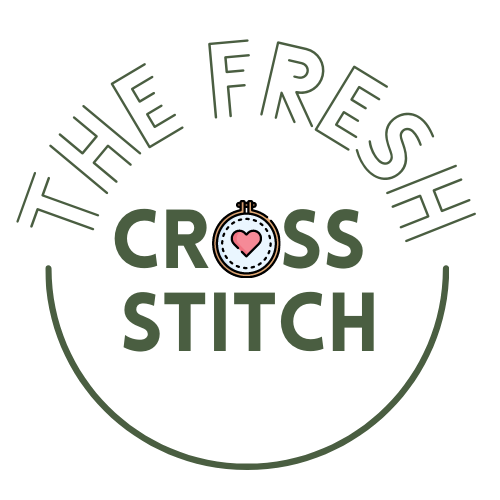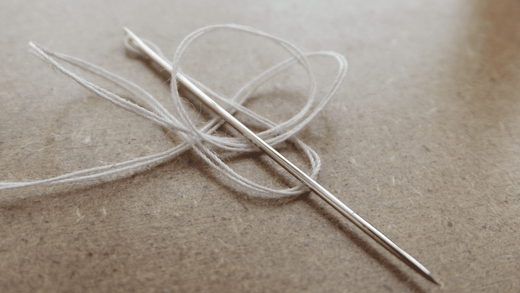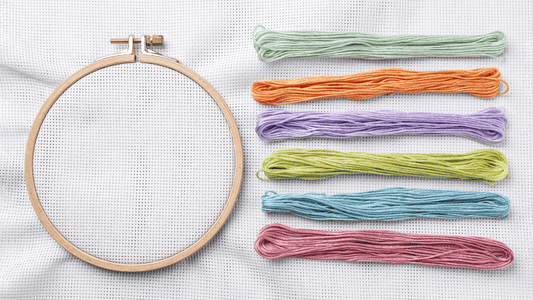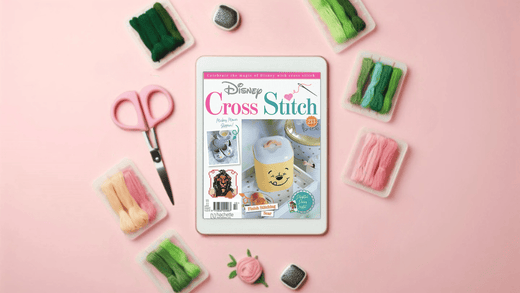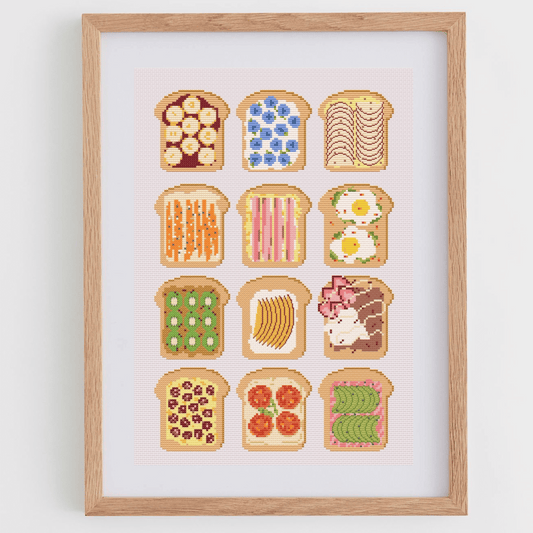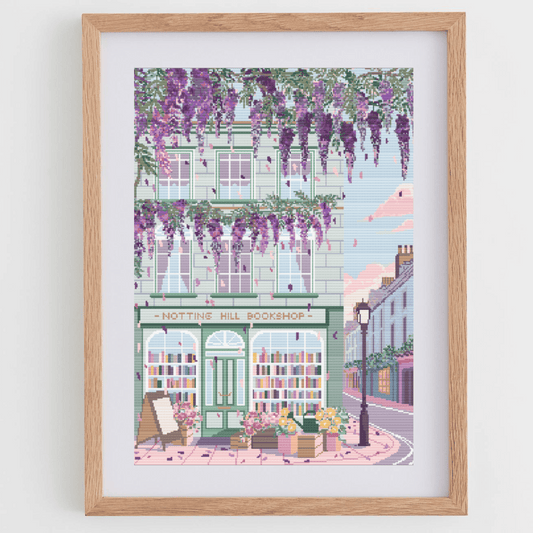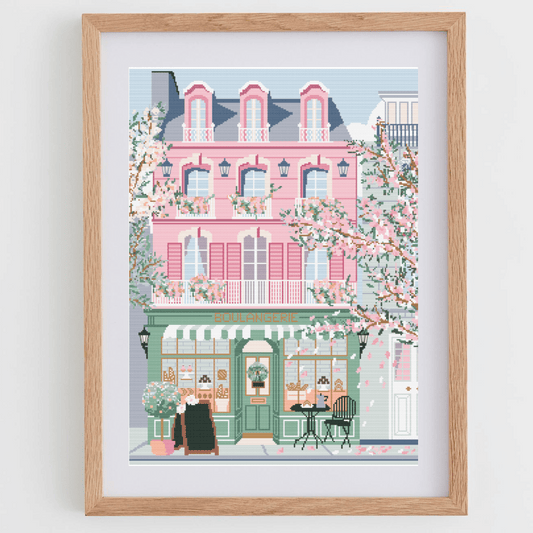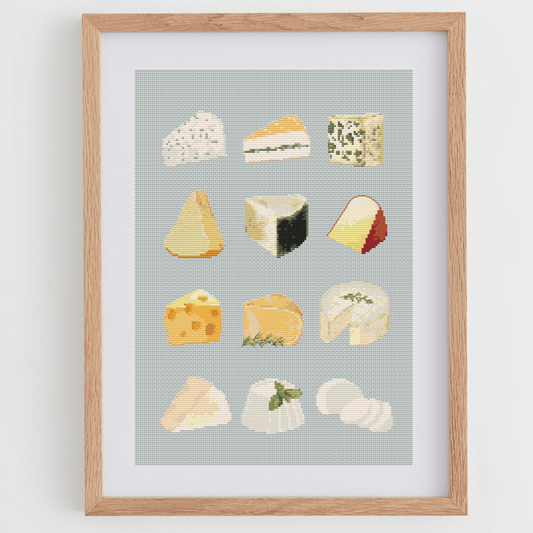They are often confused, but they are not exactly the same. Embroidery and cross stitch are very similar and have been around for thousands of years. While they share some tools and techniques, there are subtle differences that make each one unique. In this article, I’ll explain the difference between cross stitch and embroidery.
1. Embroidery vs. cross stitch
Let's start by understanding what embroidery is and what cross stitch is.
Embroidery is an art form that involves decorating fabric or material with thread, using it as if we were drawing with thread on the fabric. This art uses different types of techniques and stitches to create various line effects and add dynamism and texture to the design. Throughout history, embroidery has served both ornamental and practical purposes, and it can include a wide variety of styles, from simple works to very detailed and intricate compositions.
Cross stitch is a type of embroidery technique. It is also an art that involves decorating fabric with thread by creating designs with the stitches we make. The main difference is that cross stitch primarily uses a single technique: stitches in the shape of an "X." This technique is known for its simplicity and its ability to produce clear, detailed images through a combination of repeated stitches. It is especially known for its use in pictures, tablecloths, or clothing.
2. Tools used in embroidery and cross stitch
Since these disciplines are so similar, you’ll find that many of the tools used in both embroidery and cross stitch are the same. However, there are some differences in the materials used.
Tools for embroidery and cross stitch
These are the tools that will work for both types of needlework:
- Embroidery needles: Embroidery needles have a round point and a larger eye than traditional sewing needles, making it easier for the thread to pass through. The size of the needle can vary depending on the type of thread and fabric used. Technically, you can use any needle for cross stitch or embroidery, but using a round-tipped needle will make your work much easier, as it won’t snag on the fabric.
If you're unsure about which needles to use, I recommend reading my guide on embroidery needles.
- Embroidery threads: Embroidery and cross-stitch threads are usually the same. These threads are typically made of cotton, thicker than sewing threads, and available in a wide variety of colors to make your designs as rich as possible. They are also known for being strong and smooth, allowing them to glide easily through your stitches. Both disciplines use these types of threads, with well-known brands like DMC and Anchor, though there are others as well. Embroidery threads can be made from different materials, such as cotton, silk, wool, or metallics. Depending on the type of embroidery, thicker or finer threads are chosen.

- Hoops: A hoop is a frame, usually made of wood, used to hold the fabric taut while embroidering or cross stitching, preventing it from distorting and making the work easier. Hoops are used in almost all forms of embroidery but are particularly important in techniques such as freehand embroidery or raised embroidery. Hoops come in different sizes, and the one you choose will depend on the size of your design and personal preference. Hoops are not only useful for holding the fabric but can also be used as a frame for your design once you’re done. Personally, I love how they look for making Christmas tree decorations, as shown in the image below.
Tools for embroidery:
- Soluble fabric for embroidery: When creating an embroidery design, it's common to use a soluble fabric (or magic fabric) that serves as a template, so you know where to "draw" your stitches. While more experienced embroiderers can work freehand, using this fabric is the most common practice. All you have to do is trace the design and place the fabric on top of your material. Once you finish your embroidery, you can wash the fabric, and the template will dissolve, leaving only the original fabric and your threads.
- Embroidery markers: If you are using soluble fabric for embroidery, you may also need markers to trace the design you want to stitch.
Tools for cross stitch:
- Aida fabric: Aida fabric is the most commonly used fabric for cross stitch, though it's not the only one. This fabric is particularly used for cross stitch because it has a grid, which is a key feature in cross stitch. It is made of cotton threads organized in a small grid pattern, making it much easier to place each cross stitch in the correct position. Aida fabric comes in different grid sizes, which determines how many stitches fit per centimeter.
For more information on Aida fabric sizes, I recommend reading my guide to types of cross-stitch fabric.
In addition to Aida fabric, you can also use other fabrics like linen or evenweave fabrics, which also form small grids to guide your stitches.
- Soluble fabric for cross stitch: While the fabrics mentioned above are the most commonly used, there are alternatives if you want to use fabric that doesn't have a grid. Soluble fabric for cross stitch is a type of template that you can add to any fabric you want to use for your cross-stitch design: a tote bag, jeans, printed fabric—whatever you like! This template has an integrated grid pattern to guide your stitches. When you wash the fabric, the template dissolves, and only your threads remain intact.
3. Embroidery and cross-stitch patterns
This is, for me, one of the main differences between cross stitch and embroidery, so it deserves its own section.
Embroidery patterns:
In the image below, you can see an example of a free embroidery pattern by DMC. You can see how several images influence each other. For example, one shows the design's outline for you to trace, and another shows the embroidery technique for each area, marked with letters and numbers.
Embroidery patterns also include a thread guide to let you know exactly which colors to use.
Cross-stitch patterns:
Cross-stitch patterns are quite different due to the defined grid that characterizes the technique. These patterns are made up of a grid where each square represents one cross stitch. Each square in the pattern is assigned a color, identified by a symbol, which corresponds to the thread color you should use.

Finally, a cross-stitch pattern will come with a list of all the threads you'll need, including their color codes and symbols. It might also indicate how many stitches of each color there are, so you know approximately how much thread to buy for your cross-stitch project.

Today, you can find downloadable cross-stitch patterns online, allowing you to print them immediately or use them on a digital device, such as a computer, mobile phone, or tablet.
Discover how to read a cross-stitch pattern step by step with examples.
4. Techniques
Embroidery techniques:
Embroidery covers a wide range of techniques. Here are just a few of them:
- Chain stitch: A series of loops that form a chain, creating a decorative effect ideal for outlines or fine details. It’s a very versatile stitch used in both traditional and modern embroidery and can be worked in straight or curved lines. It’s common in embroidery for flowers, leaves, and other organic elements.
- Stem stitch: This stitch is primarily used for outlining and shaping embroidery. It is done with short angled stitches, forming a continuous line that resembles a "stem" or "twig." It’s ideal for embroidering curved lines or those that have a slight incline and is often used for creating more detailed and elegant embroidery, such as flowers and plant shapes.
- Satin stitch: Used to fill in large areas of fabric with dense or loose threads, generating textures and shadows. It is ideal when you want to cover an area entirely, providing a smooth and satin-like finish. It is worked by passing the needle back and forth in parallel lines to form a smooth, even surface.
- Split stitch: A variation of the stem stitch, where the thread is passed through twice, creating a thicker, more decorative line. It’s ideal for adding volume or for creating details that require more texture, such as flowers or raised embroidery.
- Fishbone stitch: This stitch gets its name from the pattern it forms, which resembles a fishbone. It’s worked with diagonal stitches that cross in the center, creating a "V" or zigzag shape. It’s perfect for embroidering curved lines and achieving a firm, structured design, like leaves, petals, or fabric details.
- French knot: This is a small knot made by wrapping the thread around the needle several times before passing it through the fabric. The result is a raised knot on the fabric. It is frequently used for creating small details and is ideal for embroidering flowers, petals, and other decorative elements where you want a bit of volume.
- Cross stitch: Cross stitch can also be found in embroidery patterns. It is made by forming an "X" on the fabric, using two diagonal stitches that cross in the center.
Cross-stitch techniques:
Cross stitch is known for its simplicity in terms of technique. It is almost exclusively based on the stitch that gives it its name, but it’s also common to find these techniques in cross-stitch designs:
- Cross stitch: As mentioned, the technique that gives cross stitch its name involves creating crosses that, when combined, form figures.
- Backstitch: Also known as a running stitch or straight stitch, it is commonly used to define some outlines.
- French knot: Although less frequent, French knots are used to add texture and relief to some cross-stitch works.
While both cross stitch and embroidery are techniques in the same textile art field, they present significant differences in terms of execution, tools, and patterns. Cross stitch is a structured, precise technique suited for creating clear images through a grid, while embroidery is a broader, more flexible discipline that encompasses a variety of techniques and styles. Both practices offer beautiful and creative ways to decorate and personalize textiles, and the choice between them depends on the preferences of the embroiderer and the type of project they want to undertake.
